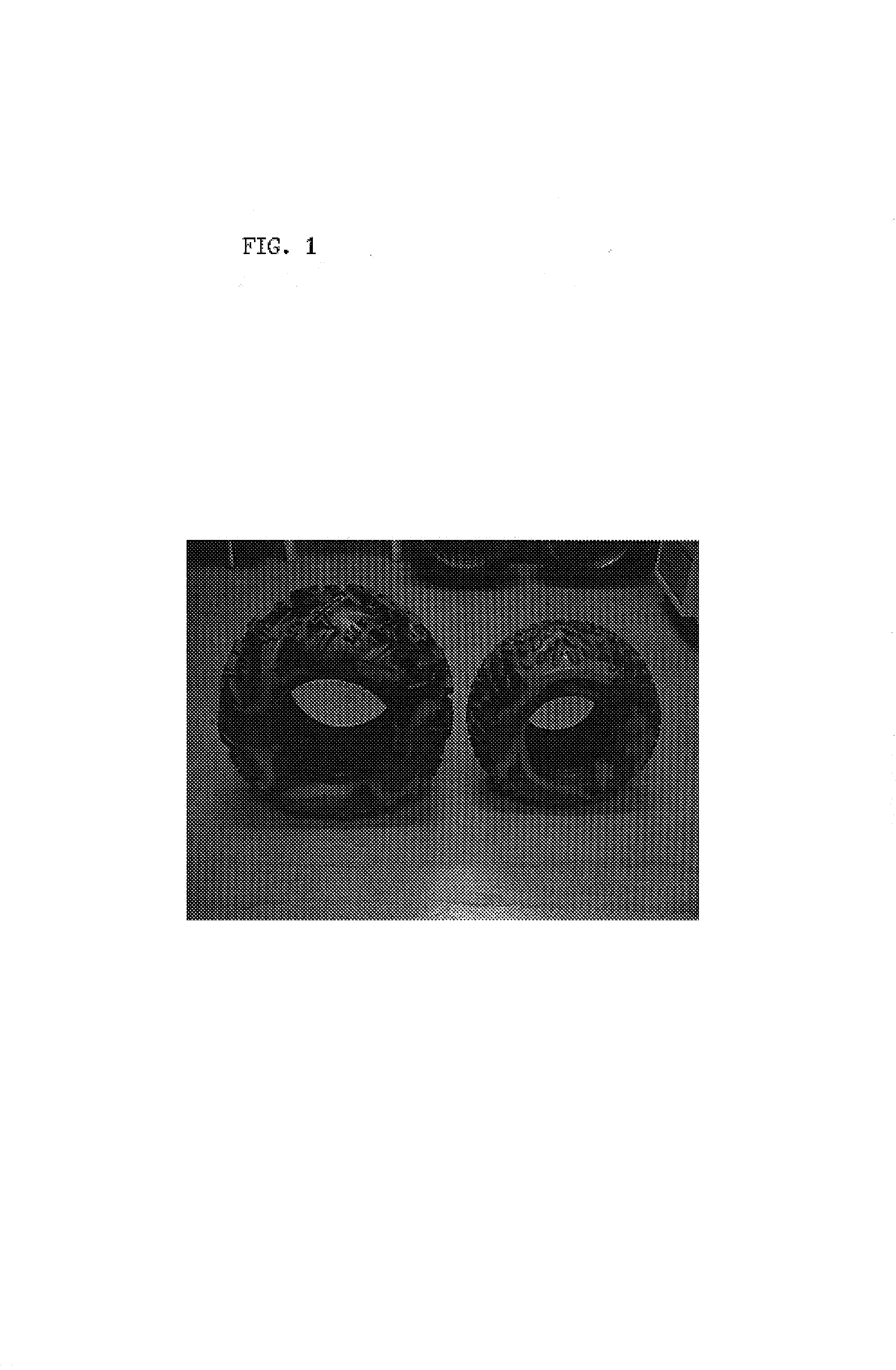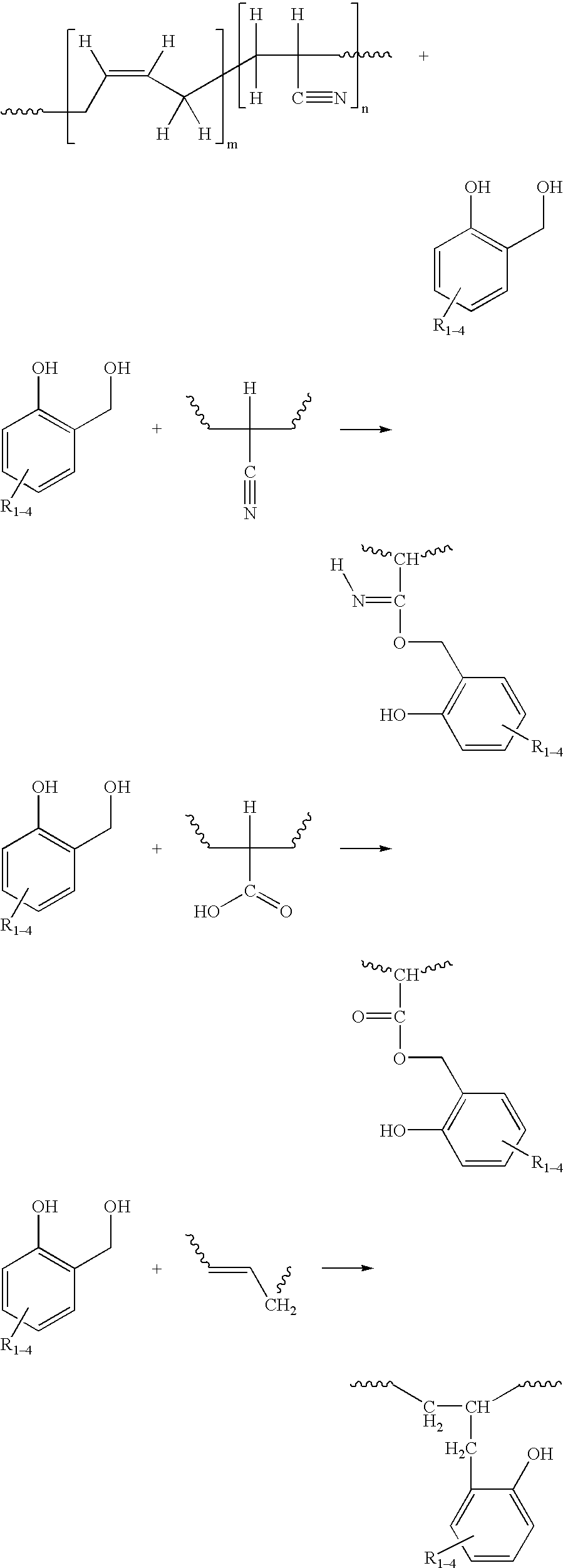Room temperature curable functionalized HNBR coating
a functionalized, room temperature technology, applied in the field of exterior coatings, can solve the problems of poor fatigue resistance of fluorocarbon elastomers, poor low temperature characteristics, poor adhesion to these substrates, etc., to enhance the aesthetics of the substrate, excellent adhesion to the elastomer substrate, and resistance to corrosive materials.
- Summary
- Abstract
- Description
- Claims
- Application Information
AI Technical Summary
Benefits of technology
Problems solved by technology
Method used
Image
Examples
example 1
Coating with 3-isocyanatopropyltriethoxysilane was uncracked at 28 hrs.
[0116]Besides having low adhesion values, the PLV 2100 coating cracks and delaminates from the rubber surface after flexing. Unpierced DeMattia flex specimens (made from a 55 durometer natural rubber compound) were coated with these same coatings and flexed in accordance with ASTM D-813. The PLV-2100 coating was severely cracked and delaminated, exposing the substrate in less than 4000 cycles. Both the baked HNBR SPE XV and Example 1 ran 80,000 cycles at which point the natural rubber substrate was cracked. There was no sign of delamination in either of the Example coatings.
example 2
Demonstrating Solution Coating Gloss Control
[0117]A wide degree of gloss control of the functionalized HNBR coatings is obtainable with the present invention coatings. Parameters such as the amount of solvent and cure times can be varied to provide a desired gloss. The example below illustrates achievement in gloss control of the present invention.
[0118]Ten grams of X-HNBR polymer Therban KA-8889 from Bayer containing 10% by weight of N762 carbon black, from Cabot Corporation, was dissolved in various solvents. The solvent solution was sprayed onto a cured rubber sheet made from a blend of natural rubber and polybutadiene. After the coating was cured, the gloss was measured at 20°, 60°, and 85° angles using a Byk-Gardner Micro TRI Glossmeter per ASTM D-523 and D-2457.
[0119]
Gloss Units10 grams polymer / black blenddissolved in the following solventsand cured with 1.2 grams20°60°85°bis[isocyanato phenyl] methaneAngleAngleAngle200 g acetone0.55.912.5185 g acetone, 8 g diisobutylketone (D...
example 3
Functionalized HNBR Water Based Latex
[0123]Water based functionalized HNBR latexes were prepared according to the present invention. A 41% solids carboxylated-HNBR latex, 404EXPLTX005 also sold as Latex B from Zeon Chemical was utilized. The following compositions were prepared.
[0124]
FormulaFormulaFormulaFormulaFormulaFormulaComponents12345641% Solids 100 100 100 100 100 100XHNBR latexgramsgramsgramsgramsgramsgramsDiphenyl-1.25 2.5 5.0———methanegramsgramsgramsDiisocyanateprepolymer1(aromatic)1,6-——— 2.5 5.0 7.5HexamethylenegramsgramsgramsDiisocyanatebasedpolyisocyanate2(aliphatic)1Desmodur ® XO 6722Bayhydur ® 302 (I,6-HDI) available from Bayer Corporation
[0125]DeMattia Flex specimens were sprayed with the latex / isocyanate combination as listed above. The DeMattia specimens were wiped with MIBK and treated with Chemlok® 7701, and the coating was applied to the specimens by spraying. All specimens ran 80,000 cycles with no signs of cracking or delamination. Adhesion is excellent.
Ozone...
PUM
| Property | Measurement | Unit |
|---|---|---|
| elongation | aaaaa | aaaaa |
| elongation | aaaaa | aaaaa |
| glass transition temperature | aaaaa | aaaaa |
Abstract
Description
Claims
Application Information
 Login to View More
Login to View More - R&D
- Intellectual Property
- Life Sciences
- Materials
- Tech Scout
- Unparalleled Data Quality
- Higher Quality Content
- 60% Fewer Hallucinations
Browse by: Latest US Patents, China's latest patents, Technical Efficacy Thesaurus, Application Domain, Technology Topic, Popular Technical Reports.
© 2025 PatSnap. All rights reserved.Legal|Privacy policy|Modern Slavery Act Transparency Statement|Sitemap|About US| Contact US: help@patsnap.com



